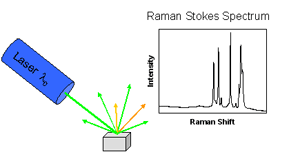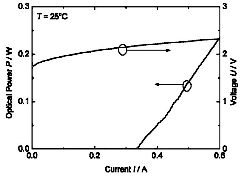From the Web Exclusive, "How Safe is Your Meat? Spectroscopy Knows"
Raman spectroscopy is based on the inelastic scattering of light and the excitation of vibrational and rotational modes of molecules. This causes a red shift of scattered photons, the so-called Stokes shift. These spectra, which deliver information on type and composition of the sample, are often called fingerprint spectra. Another advantage of this method is that water does not affect the results, making it well suited for investigating biological samples.

Fig. 1: Scheme of Raman scattering returns spectrum information.
Raman measurements require laser excitation and a collection of the scattered light by a detection system employing lenses or fibers at a suitable geometry. The light source has to be chosen with respect to the substance under study. For a large scattering intensity a short excitation wavelength should be selected according to the v4 dependency. On the other hand, fluorescence must be avoided. This is why (near-infrared) NIR excitation is often used in Raman spectroscopy. However, Raman excitation with frequency-stabilized 785 nm diode lasers (external cavity devices or diodes with internal gratings7) suffers¹ from the drop-off in sensitivity of silicon-based detectors at 1 µm, which restricts the useful Raman range to 2700 cm-1.
Another requirement is that the laser output should not be absorbed by the sample to allow obtaining information not only from the surface, but also from below the surface. In the case of meat, two main absorbers dominate the VIS-NIR absorption spectra, the heme pigment and water. In the VIS-NIR region, the minimum in the absorption spectrum is situated between 650 nm and 800 nm. Therefore, a wavelength of 671 nm was selected for this work. The benefit of this wavelength is that the full Raman range up to 4000 cm-1 is covered with high quantum efficiency of silicon-based detectors.
Fig. 2: Side view scheme of the microsystem light source.
For the hand held Raman sensor for meat, the target specifications of the diode laser were a stable wavelength at 671 nm with a spectral line width below Δv ≤ 10 cm-¹, i.e. Δλ ≤ 0.1 nm and an optical power larger than 200 mW at an overall power consumption smaller than 2 W. Broad area diode lasers emitting at 671 nm with output powers larger than 5.6 W were reported recently by Sumpf et al.² However, with a typical spectral width of about 1 nm these lasers are not suitable for Raman spectroscopy. Moreover, the wavelength of these devices shifts strongly with temperature (0.2 nm/K) and current (about 3 nm/A).
Overcoming the Problem
To overcome these problems, a micro-system based external cavity laser (ECL) with reflection Bragg grating was designed. The side-view scheme of the set-up is given in Figure 2. The whole device was mounted on an AlN micro-optical bench with a length of 13 mm and a width of 4 mm.
As gain medium a broad area diode laser with a stripe width of 30 µm and a length of 2 mm was used. The semiconductor material is comparable to the above-referred lasers, but for the ECL the front facet had a reflectivity of 1% whereas the rear side was antireflection coated with a reflectivity below 5x10-4. This device showed amplified spontaneous emission between 660 nm and 685 nm.

Fig. 3: Power current characteristic of microbench laser system.
This gain medium was placed on the micro-optical bench. The light from the rear side of the laser was collimated with a fast axis (FAC) and a slow axis collimator (SAC). A reflecting Bragg grating (RBG) from Optigrate³ with a reflectivity larger than 90% acts as rear side mirror. The light from the output facet is collimated by the same set of FAC and a SAC lenses mounted on the micro-optical bench.
The adjustment of the optics and the grating was performed actively. The optical elements were adjusted with a 6-axes precision alignment system. This is necessary for efficient feedback. A change in the angle position Δα of the RBG in the described laser system of only 0.044° causes a decrease in the optical output power of 50%. After the alignment, the optical components were fixed using UV-curing glue. This technology is based on a space qualified mounted technology developed at the FBH. For our experiments the micro-bench is soldered on a standardized conduction cooled heatsink with a footprint of 25 mm x 25 mm.
The threshold current is /th = 335 mA, the slope efficiency is S = 0.9 W/A. The efficiency is comparable to those of standard broad area lasers and shows that the inset of the micro-optics does not deteriorate the efficiency of the devices. The targeted output power of 200 mW is reached at an excitation current of /200mW = 560 mA and a voltage U200mW = 2.3 V. The electrical power to reach 200 mW is herewith Pel-200mW 1.3 W.
Spectra were recorded with a resolution better than 9 pm. The peak wavelength λ = 671.0 nm is constant within the experimental resolution from the laser threshold up to P = 200 mW. Throughout the entire output power range, 95% of the emitted power lies within a spectral window of 0.1 nm. The suitability of the laser source was proven in Raman spectroscopic experiments for well-known substances such as polyethylene. It was possible to resolve Raman-lines with a line width of 6 cm-¹. Due to the low power consumption, the micro-bench ECL can be implemented into the mobile Raman sensor system.
For more information, visit: How Safe is Your Meat? Spectroscopy Knows
1 H. Wenzel, A. Klehr, M. Braun, F. Bugge, G. Erbert, J. Fricke, A. Knauer, P. Ressel, B. Sumpf, M. Weyers, G. Tränkle
Design and realization of high-power DFB lasers
Proceedings SPIE, "Physics and Applications of Optoelectronic Devices",
vol. 5594, pp. 110-123 (2004)
2 B. Sumpf, M. Zorn, M. Maiwald, R. Staske, J. Fricke, P. Ressel, G. Erbert, M. Weyers, G. Tränkle
“5.6 W broad area lasers with a vertical far field angle of 31° emitting at 670 nm”
Photonics Technology Letters 20, 575-577 (2008)
3 L. Glebov
“Fluorinated silicate glass for conventional and holographic optical elements”
Window and Dome Technologies and Materials X, Editor: R. W. Tustison,
Proceedings of SPIE Vol. 6545, 654507, 2007.